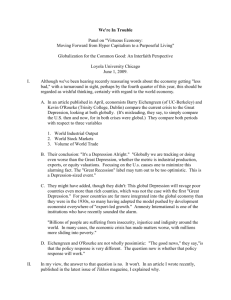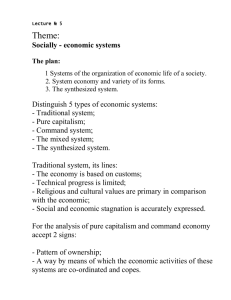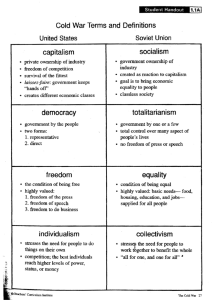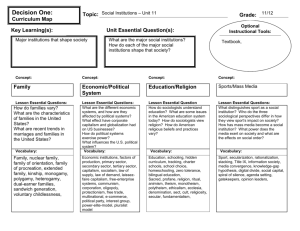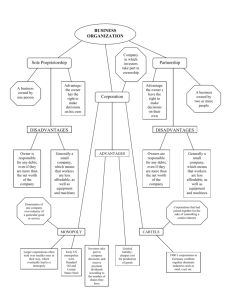American Economic History Since 1865
advertisement
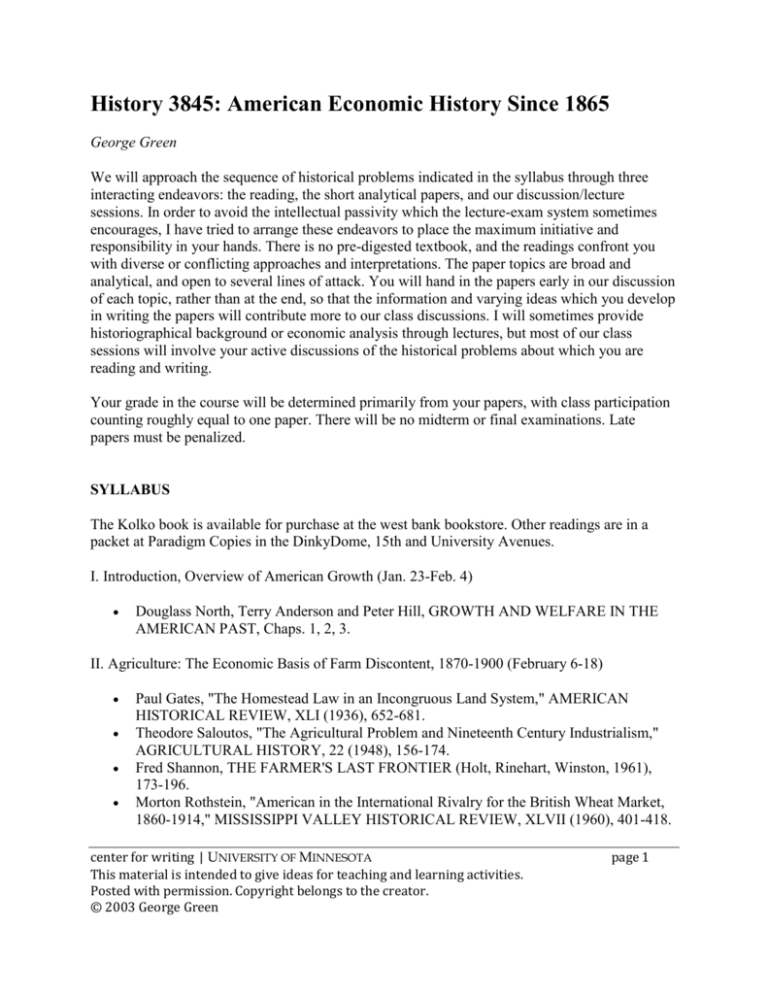
History 3845: American Economic History Since 1865 George Green We will approach the sequence of historical problems indicated in the syllabus through three interacting endeavors: the reading, the short analytical papers, and our discussion/lecture sessions. In order to avoid the intellectual passivity which the lecture-exam system sometimes encourages, I have tried to arrange these endeavors to place the maximum initiative and responsibility in your hands. There is no pre-digested textbook, and the readings confront you with diverse or conflicting approaches and interpretations. The paper topics are broad and analytical, and open to several lines of attack. You will hand in the papers early in our discussion of each topic, rather than at the end, so that the information and varying ideas which you develop in writing the papers will contribute more to our class discussions. I will sometimes provide historiographical background or economic analysis through lectures, but most of our class sessions will involve your active discussions of the historical problems about which you are reading and writing. Your grade in the course will be determined primarily from your papers, with class participation counting roughly equal to one paper. There will be no midterm or final examinations. Late papers must be penalized. SYLLABUS The Kolko book is available for purchase at the west bank bookstore. Other readings are in a packet at Paradigm Copies in the DinkyDome, 15th and University Avenues. I. Introduction, Overview of American Growth (Jan. 23-Feb. 4) Douglass North, Terry Anderson and Peter Hill, GROWTH AND WELFARE IN THE AMERICAN PAST, Chaps. 1, 2, 3. II. Agriculture: The Economic Basis of Farm Discontent, 1870-1900 (February 6-18) Paul Gates, "The Homestead Law in an Incongruous Land System," AMERICAN HISTORICAL REVIEW, XLI (1936), 652-681. Theodore Saloutos, "The Agricultural Problem and Nineteenth Century Industrialism," AGRICULTURAL HISTORY, 22 (1948), 156-174. Fred Shannon, THE FARMER'S LAST FRONTIER (Holt, Rinehart, Winston, 1961), 173-196. Morton Rothstein, "American in the International Rivalry for the British Wheat Market, 1860-1914," MISSISSIPPI VALLEY HISTORICAL REVIEW, XLVII (1960), 401-418. center for writing | UNIVERSITY OF MINNESOTA This material is intended to give ideas for teaching and learning activities. Posted with permission. Copyright belongs to the creator. © 2003 George Green page 1 Anne Mayhew, "A Reappraisal of the Causes of Farm Protest in the United States," JOURNAL OF ECONOMIC HISTORY, 32 (1972), 464-476. Robert Higgs, "Railroad Rates and the Populist Uprising," AGRICULTURAL HISTORY, 44 (1970), 291-297. III. Rise of Big Business (Feb. 20-March 6) Alfred D. Chandler, "The Beginnings of 'Big Business' in American Industry," BUSINESS HISTORY REVIEW, 33 (1959), 1-31. Ralph Nelson, MERGER MOVEMENTS IN AMERICAN INDUSTRY (Princeton U. Press, 1959), 3-7, 71-105. Naomi Lamoreaux, THE GREAT MERGER MOVEMENT IN AMERICAN BUSINESS, 1895-1904 (Cambridge University Press, 1985), 118-126, 134-147, 187-194. David F. Noble, AMERICA BY DESIGN; SCIENCE, TECHNOLOGY AND THE RISE OF CORPORATE CAPITALISM (Oxford University Press, 1977), xxi-xxvi, 3-19. Gabriel Kolko, THE TRIUMPH OF CONSERVATISM, 1900-1916, Introduction and Chaps. 1-3, 10, and Conclusion. IV. Finance Capitalism and Financial Reforms (March 8-29; no class March 18-22) George Green, "Financial Intermediaries," ENCYCLOPEDIA OF AMERICAN ECONOMIC HISTORY (Charles Scribner's Sons, 1980), 707-726. Henry Parker Willis, "Banking and Monetary Reform," CHANGES IN THE BANKING AND CURRENCY SYSTEM OF THE UNITED STATES, 63rd Congress, 1st Session, House Report No. 69 (1913), 3-7, 11-12, 16-17, 19-20. N.S.B. Gras and Henrietta Larson, "Financial Capitalism," in their CASEBOOK IN AMERICAN BUSINESS HISTORY (Appleton-Century-Crofts, Inc., 1939) 10-12. Jonathan Hughes, "J. Pierpont Morgan, The Investment Banker as Statesman," THE VITAL FEW (Oxford U. Press, 1965), 399-454. Lance Davis, "Capital Immobilities and Finance Capitalism: A Study of Economic Evolution in the U.S., 1820-1920," EXPLORATIONS IN ENTREPRENEURIAL HISTORY, 1 (1963), 88-105. Phillip Cagan, "The First Fifty Years of the National Banking System," in Dean Carson, ed., BANKING AND MONETARY STUDIES (Homewood, IL: Richard D. Irwin, 1963), 15-42. Kolko, THE TRIUMPH OF CONSERVATISM, Chaps. 6 and 9. V. The 1920s and the Great Depression (April 1-22; no class April 19) William Leuchtenburg, THE PERILS OF PROSPERITY (University of Chicago Press, 1958), pp.178-202. Arthur B. Adams, TREND OF BUSINESS, 1922-1932 (Harper & Row, 1932), pp.24-29, 30-39, 46-49, 69-70. center for writing | UNIVERSITY OF MINNESOTA This material is intended to give ideas for teaching and learning activities. Posted with permission. Copyright belongs to the creator. © 2003 George Green page 2 Gardiner C. Means, "Price Inflexibility and the Requirements of a Stabilizing Monetary Policy," JOURNAL OF THE AMERICAN STATISTICAL ASSOCIATION, XXX (1935), 401-413. Franklin D. Roosevelt, "The Fireside Chat of April 14, 1938," in Samuel I. Rosenmann, THE PUBLIC PAPERS AND ADDRESSES OF FRANKLIN D. ROOSEVELT (NY: Macmillan, 1941), Vol. VII, 236-248. Alvin H. Hansen, "Economic Progress and Declining Population Growth," AMERICAN ECONOMIC REVIEW, XXIX (March, 1939), 1-13. John Kenneth Galbraith, THE GREAT CRASH, 1929 (Boston: Houghton Mifflin, 1961), pp.173-193. Robert A. Gordon, BUSINESS FLUCTUATIONS (2nd Edition, Harper & Row, 1952), pp.406-13, 444-450. Lester V. Chandler, AMERICAN MONETARY POLICY, 1928-1941 (Harper & Row, 1971), 3-17, 29-36, 83-89, 116-128, 349-359. Gilbert Burck and Charles Silberman, "Why the Depression Lasted So Long," FORTUNE (March, 1955). Lewis Kimmel, FEDERAL BUDGET AND FISCAL POLICY, 1789-1958 (Brookings Institution, 1959), pp.213-228. E. Cary Brown, "Fiscal Policy in the Thirties: A Reappraisal," AMERICAN ECONOMIC REVIEW, 46 (1956), 857-879. Michael Bernstein, THE GREAT DEPRESSION: DELAYED RECOVERY AND ECONOMIC CHANGE IN AMERICA, 1929-1939 (Cambridge University Press, 1987), pp.1-10, 21-40 VI. Stability Problems of Modern Capitalism (April 24-May 10; no class May 3) Lester V. Chandler, AMERICA'S GREATEST DEPRESSION, 1929-1941 (Harper & Row, 1970), pp.241-245. E. Cary Brown, "Federal Fiscal Policy in the Postwar Period," in Ralph E. Freeman (ed.), POSTWAR ECONOMIC TRENDS IN THE UNITED STATES (Harper & Row, 1960), pp.141-188. Edward Mason, "Interests, Ideologies and the Problem of Stability and Growth," AMERICAN ECONOMIC REVIEW, PAPERS AND PROCEEDINGS, LIII (March, 1963), 1-18. John Kenneth Galbraith, "The New Industrial State: The Role of the State," THE LISTENER, LXXVI (Dec. 8, 1966), pp.841-43, 853. Arthur Okun, "The Invisible Handshake and the Inflationary Process," CHALLENGE, (Jan.-Feb. 1980), 5-12. Moses Abramovitz, "Welfare Quandaries and Productivity Concerns," AMERICAN ECONOMIC REVIEW, PROCEEDINGS, 71(1981),1-17. center for writing | UNIVERSITY OF MINNESOTA This material is intended to give ideas for teaching and learning activities. Posted with permission. Copyright belongs to the creator. © 2003 George Green page 3 PAPER ASSIGNMENTS Write a thoughtful, critical essay on four of the following five "problem" questions. You may omit one topic of your own choosing, except that everyone must write on Topic V. The essays are to be based on the regular course readings. Assume that your reader has also read them; don't waste time or space just summarizing the readings. Instead, identify the major historical or conceptual issues which underlie the problem, give your critical evaluation of the various authors on these issues, and offer your own judgments on the large question itself. Each essay should be 3-5 pages, double-spaced. Late papers must be sharply penalized and should be approved in advance; the papers must be completed to receive a grade for the course. I. What was the economic basis of the farm protest movements of the late nineteenth century? (Due Friday, February 8.) II. What were the main causes of the rise of "big business" in America in the late nineteenth century? (Due Friday, February 22.) III. What were the problems and inadequacies of American banking and finance capitalism (1865-1913), and how effectively did the Federal Reserve Act and other financial "reforms" of the early twentieth century deal with them? (Due Monday, March 11.) IV. What caused the Great Depression, and why was it so severe and enduring? (This paper should be 8-10 pages long, and will count double. Due Friday, April 5.) V. How does the rise of corporate capitalism and "the new industrial state" affect the vulnerability of the modern economy to depression, stagnation of growth, and inflation? (Due Friday, April 26.) Green, George. Syllabus, History 3845: American Economic History Since 1865. History Department, University of Minnesota. 22 May 2003. center for writing | UNIVERSITY OF MINNESOTA This material is intended to give ideas for teaching and learning activities. Posted with permission. Copyright belongs to the creator. © 2003 George Green page 4


